Financial Budgeting, Performance, and Risk Management Report
VerifiedAdded on 2020/05/08
|21
|2632
|37
Report
AI Summary
This report provides a comprehensive overview of the budgeting process, encompassing various aspects of financial planning and analysis. It begins with the development of key budgets such as sales, purchase, and expense budgets, followed by the creation of a budgeted income statement and production budget. The report also includes a performance report with a flexible budget and a cash budget. Further, it delves into the preparation of financial budgets, addressing the parameters of budgeted income statements, cash budgets, and balance sheets. The report also explores financial risks and strategies for mitigation, including asset-backed and credit risks. The report includes working notes for calculations. Additionally, the report addresses the pros and cons of budgeting, different budget types for manufacturing operations, and the role of a master budget, providing a well-rounded perspective on financial management.
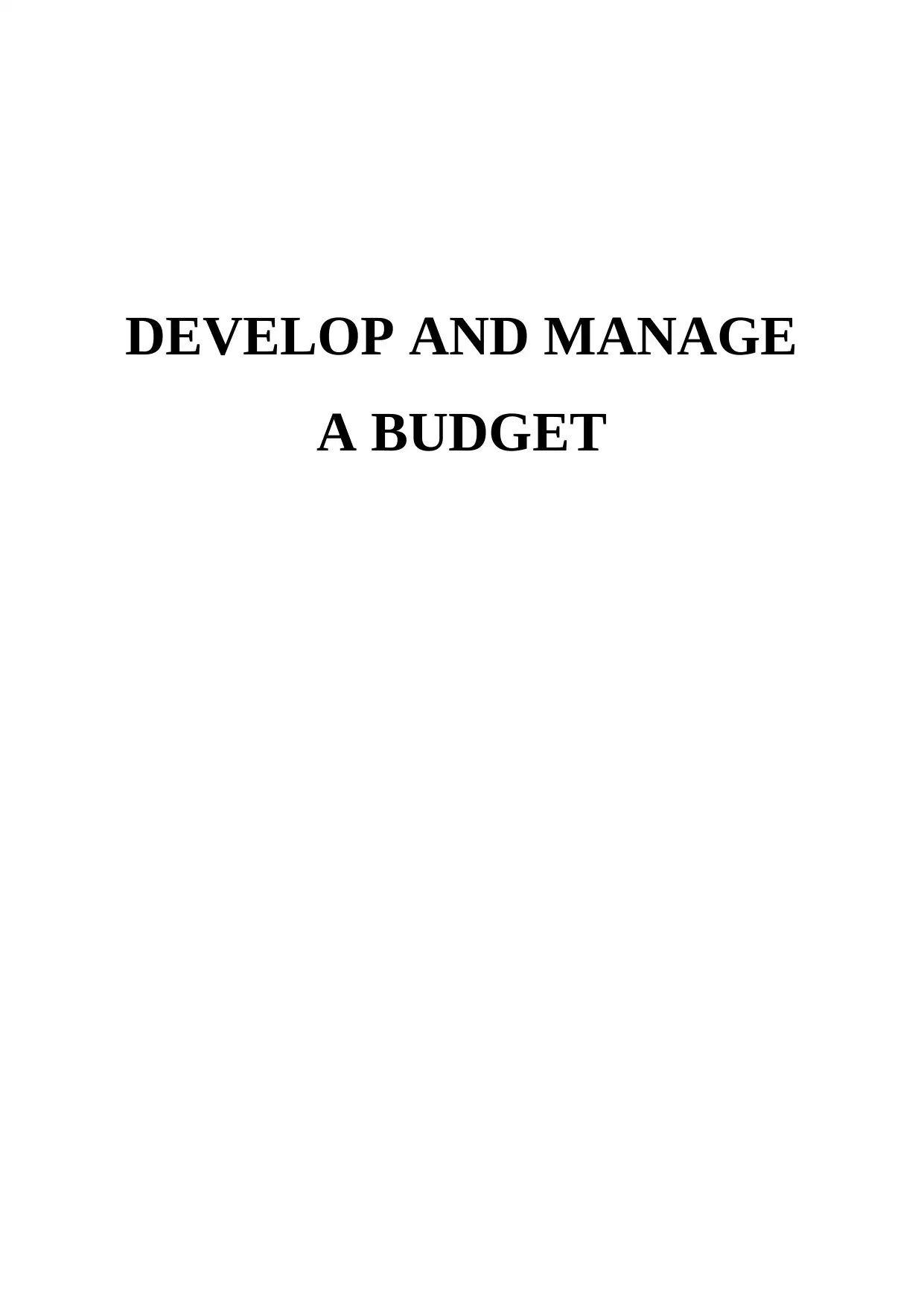
DEVELOP AND MANAGE
A BUDGET
A BUDGET
Paraphrase This Document
Need a fresh take? Get an instant paraphrase of this document with our AI Paraphraser
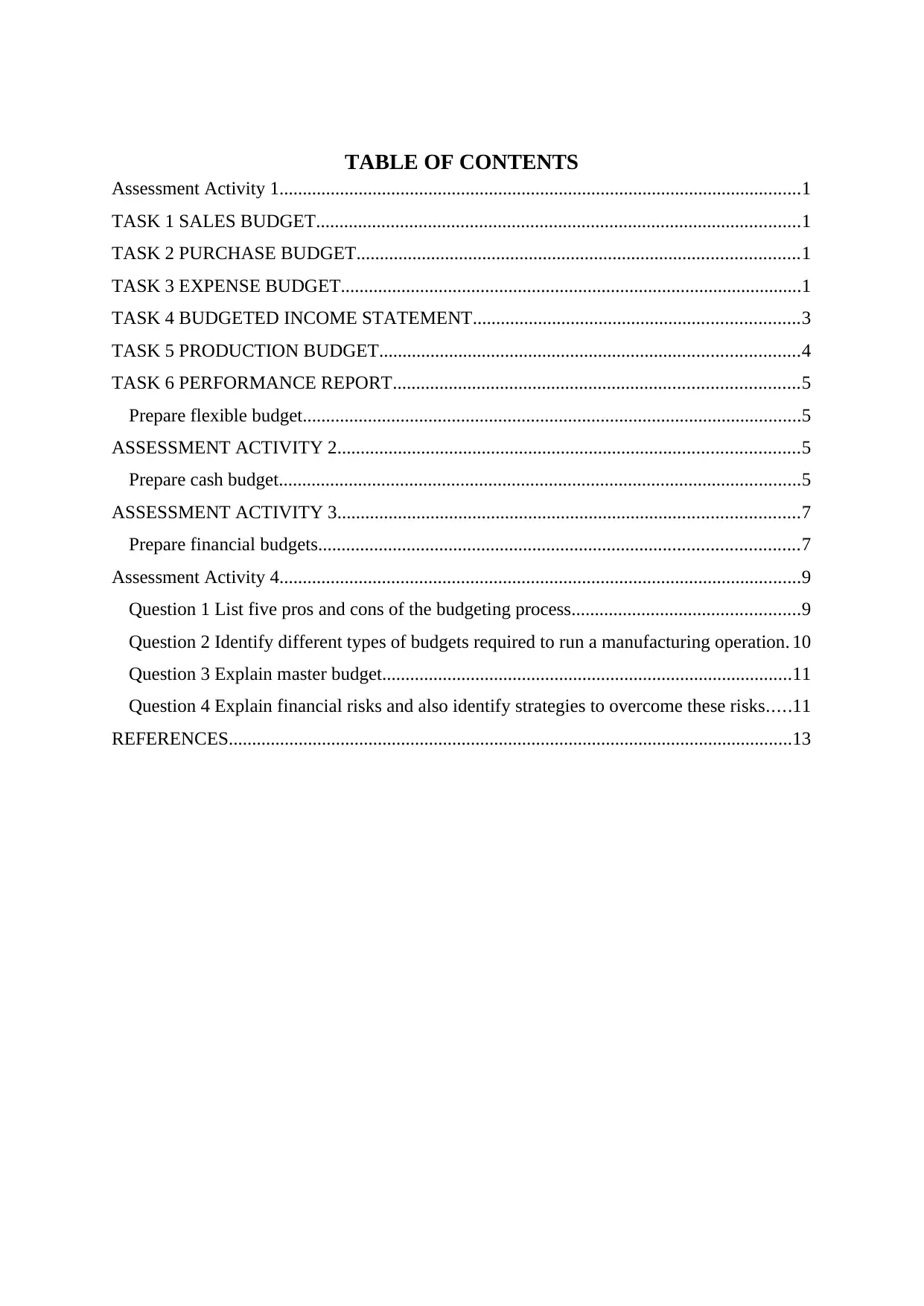
TABLE OF CONTENTS
Assessment Activity 1................................................................................................................1
TASK 1 SALES BUDGET........................................................................................................1
TASK 2 PURCHASE BUDGET...............................................................................................1
TASK 3 EXPENSE BUDGET...................................................................................................1
TASK 4 BUDGETED INCOME STATEMENT......................................................................3
TASK 5 PRODUCTION BUDGET..........................................................................................4
TASK 6 PERFORMANCE REPORT.......................................................................................5
Prepare flexible budget...........................................................................................................5
ASSESSMENT ACTIVITY 2...................................................................................................5
Prepare cash budget................................................................................................................5
ASSESSMENT ACTIVITY 3...................................................................................................7
Prepare financial budgets.......................................................................................................7
Assessment Activity 4................................................................................................................9
Question 1 List five pros and cons of the budgeting process.................................................9
Question 2 Identify different types of budgets required to run a manufacturing operation. 10
Question 3 Explain master budget........................................................................................11
Question 4 Explain financial risks and also identify strategies to overcome these risks.....11
REFERENCES.........................................................................................................................13
Assessment Activity 1................................................................................................................1
TASK 1 SALES BUDGET........................................................................................................1
TASK 2 PURCHASE BUDGET...............................................................................................1
TASK 3 EXPENSE BUDGET...................................................................................................1
TASK 4 BUDGETED INCOME STATEMENT......................................................................3
TASK 5 PRODUCTION BUDGET..........................................................................................4
TASK 6 PERFORMANCE REPORT.......................................................................................5
Prepare flexible budget...........................................................................................................5
ASSESSMENT ACTIVITY 2...................................................................................................5
Prepare cash budget................................................................................................................5
ASSESSMENT ACTIVITY 3...................................................................................................7
Prepare financial budgets.......................................................................................................7
Assessment Activity 4................................................................................................................9
Question 1 List five pros and cons of the budgeting process.................................................9
Question 2 Identify different types of budgets required to run a manufacturing operation. 10
Question 3 Explain master budget........................................................................................11
Question 4 Explain financial risks and also identify strategies to overcome these risks.....11
REFERENCES.........................................................................................................................13
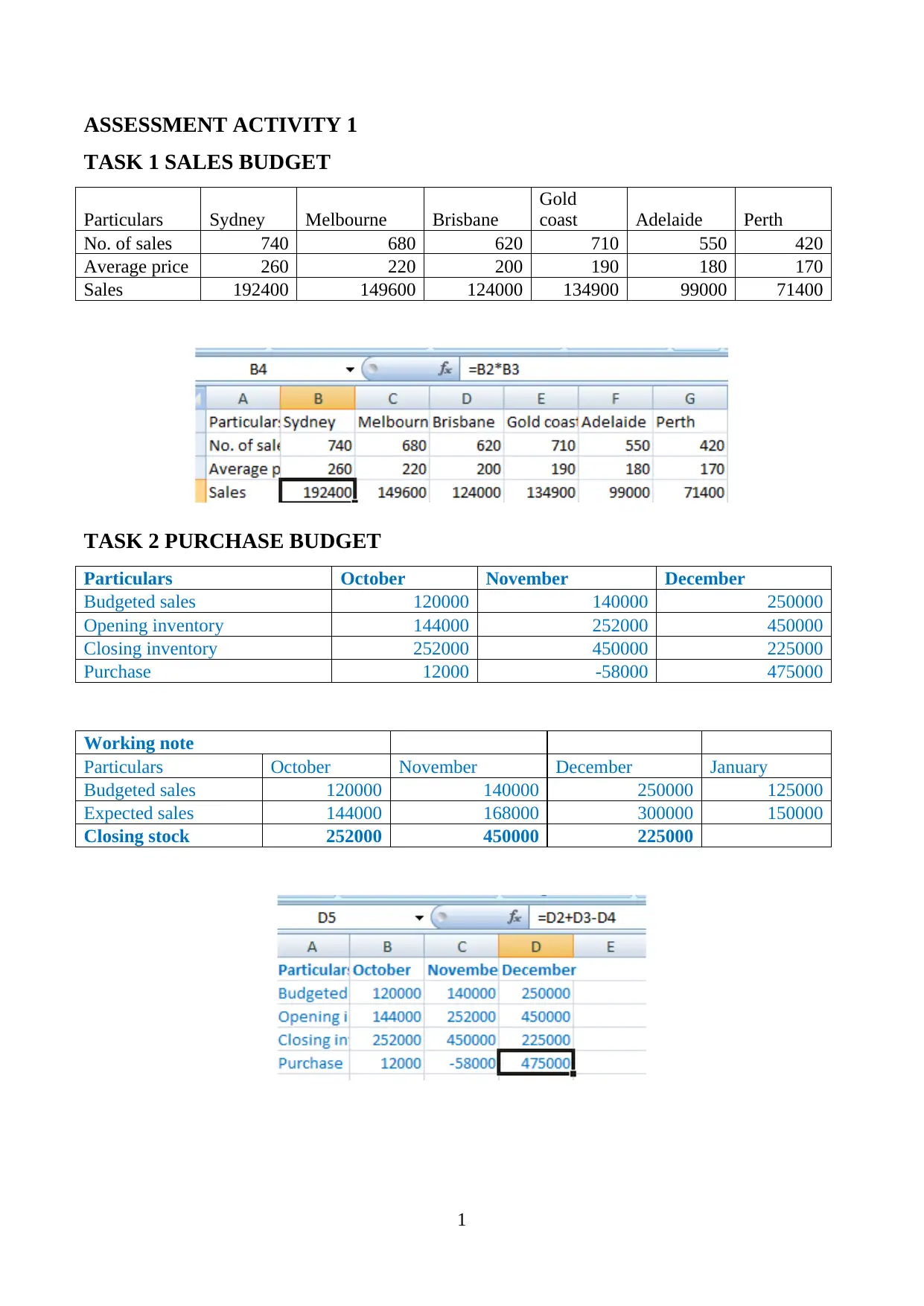
ASSESSMENT ACTIVITY 1
TASK 1 SALES BUDGET
Particulars Sydney Melbourne Brisbane
Gold
coast Adelaide Perth
No. of sales 740 680 620 710 550 420
Average price 260 220 200 190 180 170
Sales 192400 149600 124000 134900 99000 71400
TASK 2 PURCHASE BUDGET
Particulars October November December
Budgeted sales 120000 140000 250000
Opening inventory 144000 252000 450000
Closing inventory 252000 450000 225000
Purchase 12000 -58000 475000
Working note
Particulars October November December January
Budgeted sales 120000 140000 250000 125000
Expected sales 144000 168000 300000 150000
Closing stock 252000 450000 225000
1
TASK 1 SALES BUDGET
Particulars Sydney Melbourne Brisbane
Gold
coast Adelaide Perth
No. of sales 740 680 620 710 550 420
Average price 260 220 200 190 180 170
Sales 192400 149600 124000 134900 99000 71400
TASK 2 PURCHASE BUDGET
Particulars October November December
Budgeted sales 120000 140000 250000
Opening inventory 144000 252000 450000
Closing inventory 252000 450000 225000
Purchase 12000 -58000 475000
Working note
Particulars October November December January
Budgeted sales 120000 140000 250000 125000
Expected sales 144000 168000 300000 150000
Closing stock 252000 450000 225000
1
⊘ This is a preview!⊘
Do you want full access?
Subscribe today to unlock all pages.

Trusted by 1+ million students worldwide
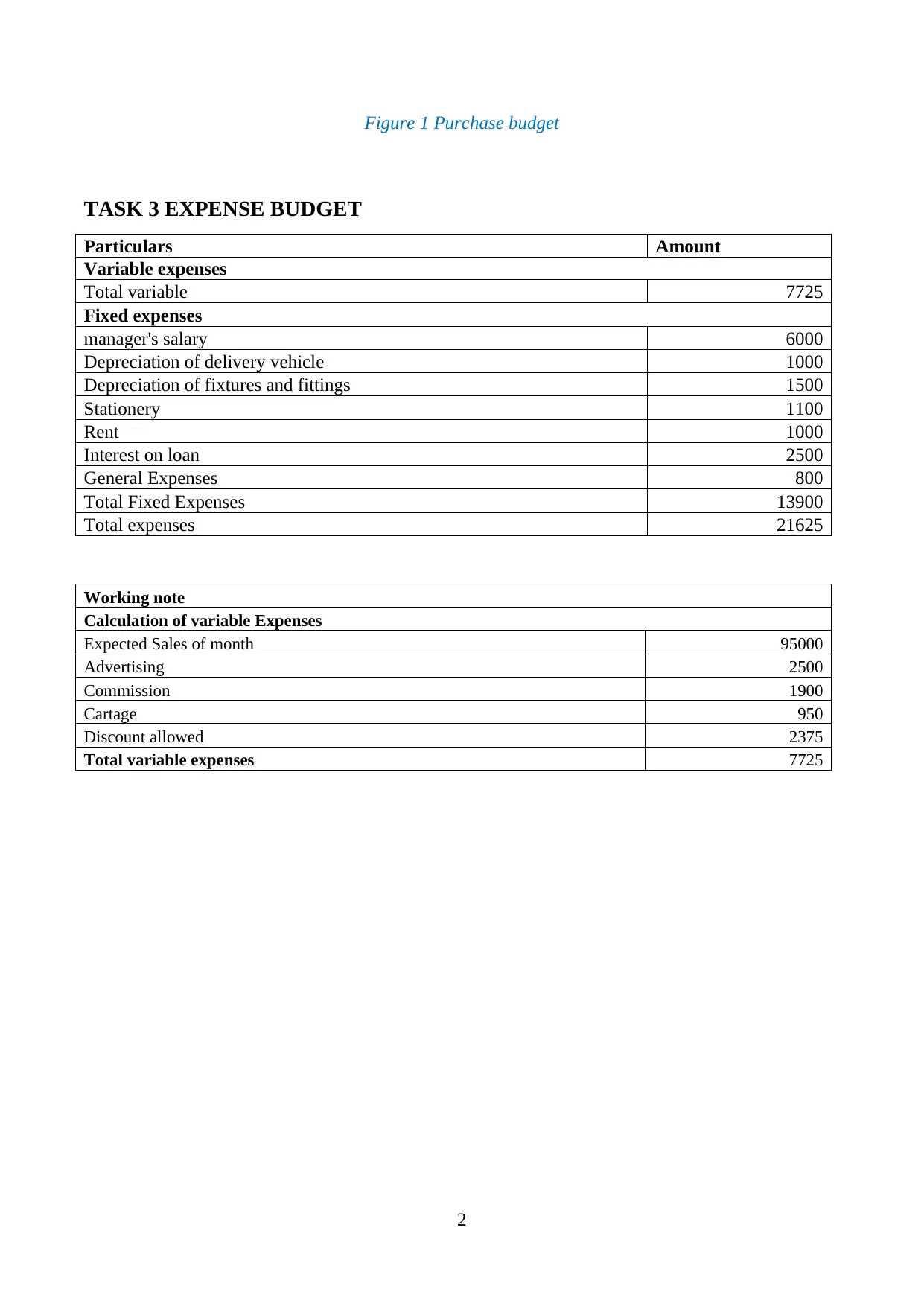
Figure 1 Purchase budget
TASK 3 EXPENSE BUDGET
Particulars Amount
Variable expenses
Total variable 7725
Fixed expenses
manager's salary 6000
Depreciation of delivery vehicle 1000
Depreciation of fixtures and fittings 1500
Stationery 1100
Rent 1000
Interest on loan 2500
General Expenses 800
Total Fixed Expenses 13900
Total expenses 21625
Working note
Calculation of variable Expenses
Expected Sales of month 95000
Advertising 2500
Commission 1900
Cartage 950
Discount allowed 2375
Total variable expenses 7725
2
TASK 3 EXPENSE BUDGET
Particulars Amount
Variable expenses
Total variable 7725
Fixed expenses
manager's salary 6000
Depreciation of delivery vehicle 1000
Depreciation of fixtures and fittings 1500
Stationery 1100
Rent 1000
Interest on loan 2500
General Expenses 800
Total Fixed Expenses 13900
Total expenses 21625
Working note
Calculation of variable Expenses
Expected Sales of month 95000
Advertising 2500
Commission 1900
Cartage 950
Discount allowed 2375
Total variable expenses 7725
2
Paraphrase This Document
Need a fresh take? Get an instant paraphrase of this document with our AI Paraphraser
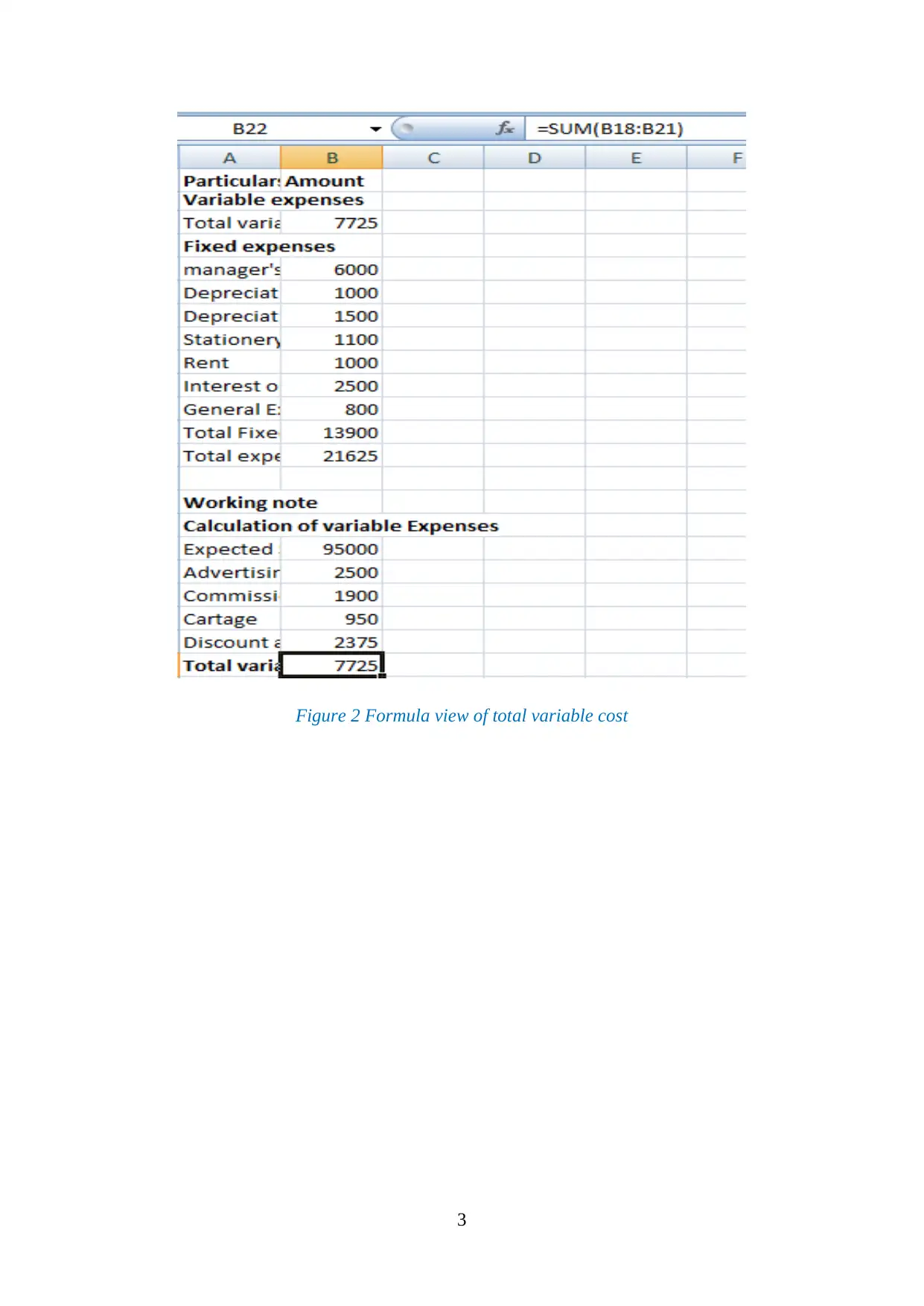
Figure 2 Formula view of total variable cost
3
3
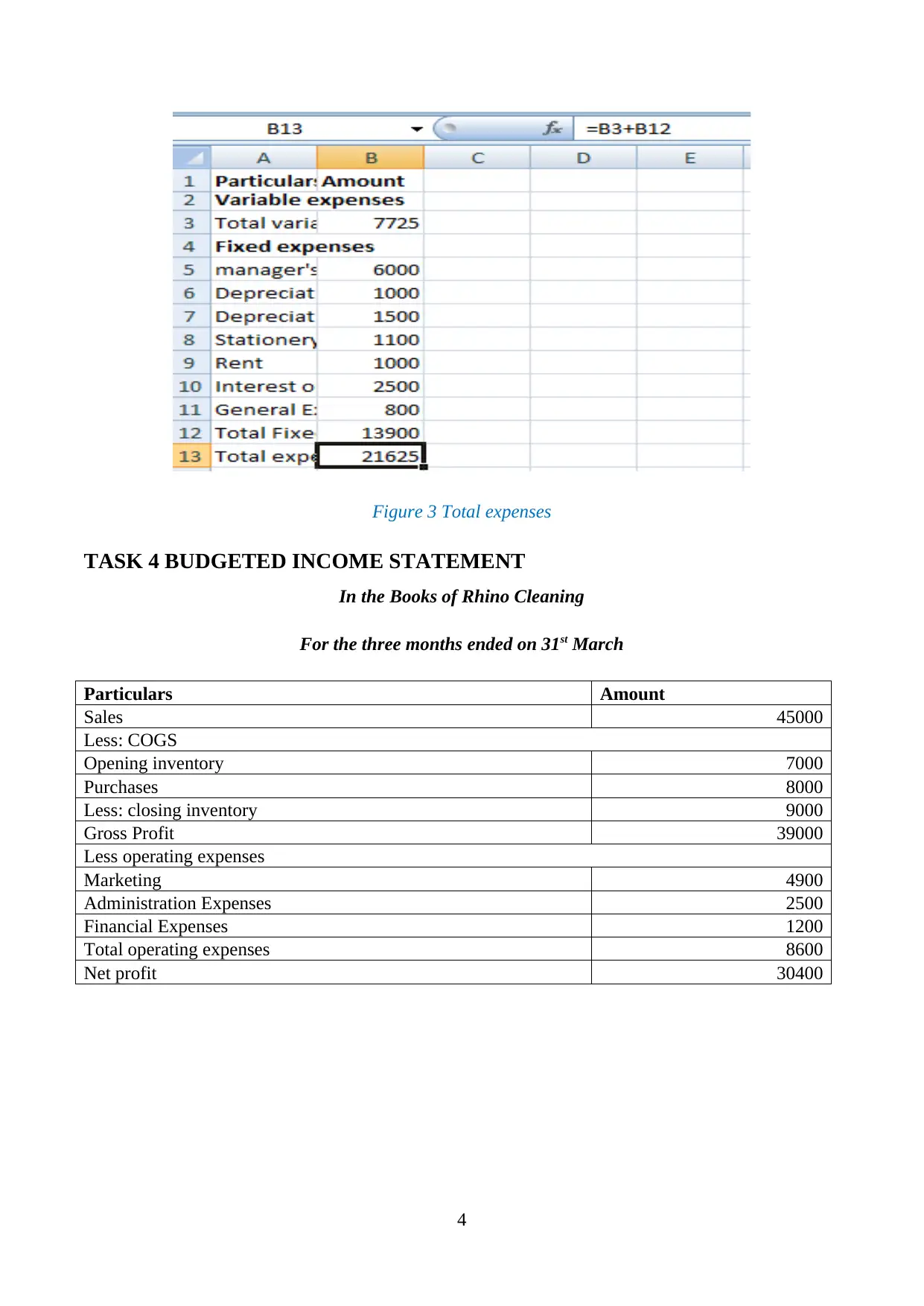
Figure 3 Total expenses
TASK 4 BUDGETED INCOME STATEMENT
In the Books of Rhino Cleaning
For the three months ended on 31st March
Particulars Amount
Sales 45000
Less: COGS
Opening inventory 7000
Purchases 8000
Less: closing inventory 9000
Gross Profit 39000
Less operating expenses
Marketing 4900
Administration Expenses 2500
Financial Expenses 1200
Total operating expenses 8600
Net profit 30400
4
TASK 4 BUDGETED INCOME STATEMENT
In the Books of Rhino Cleaning
For the three months ended on 31st March
Particulars Amount
Sales 45000
Less: COGS
Opening inventory 7000
Purchases 8000
Less: closing inventory 9000
Gross Profit 39000
Less operating expenses
Marketing 4900
Administration Expenses 2500
Financial Expenses 1200
Total operating expenses 8600
Net profit 30400
4
⊘ This is a preview!⊘
Do you want full access?
Subscribe today to unlock all pages.

Trusted by 1+ million students worldwide
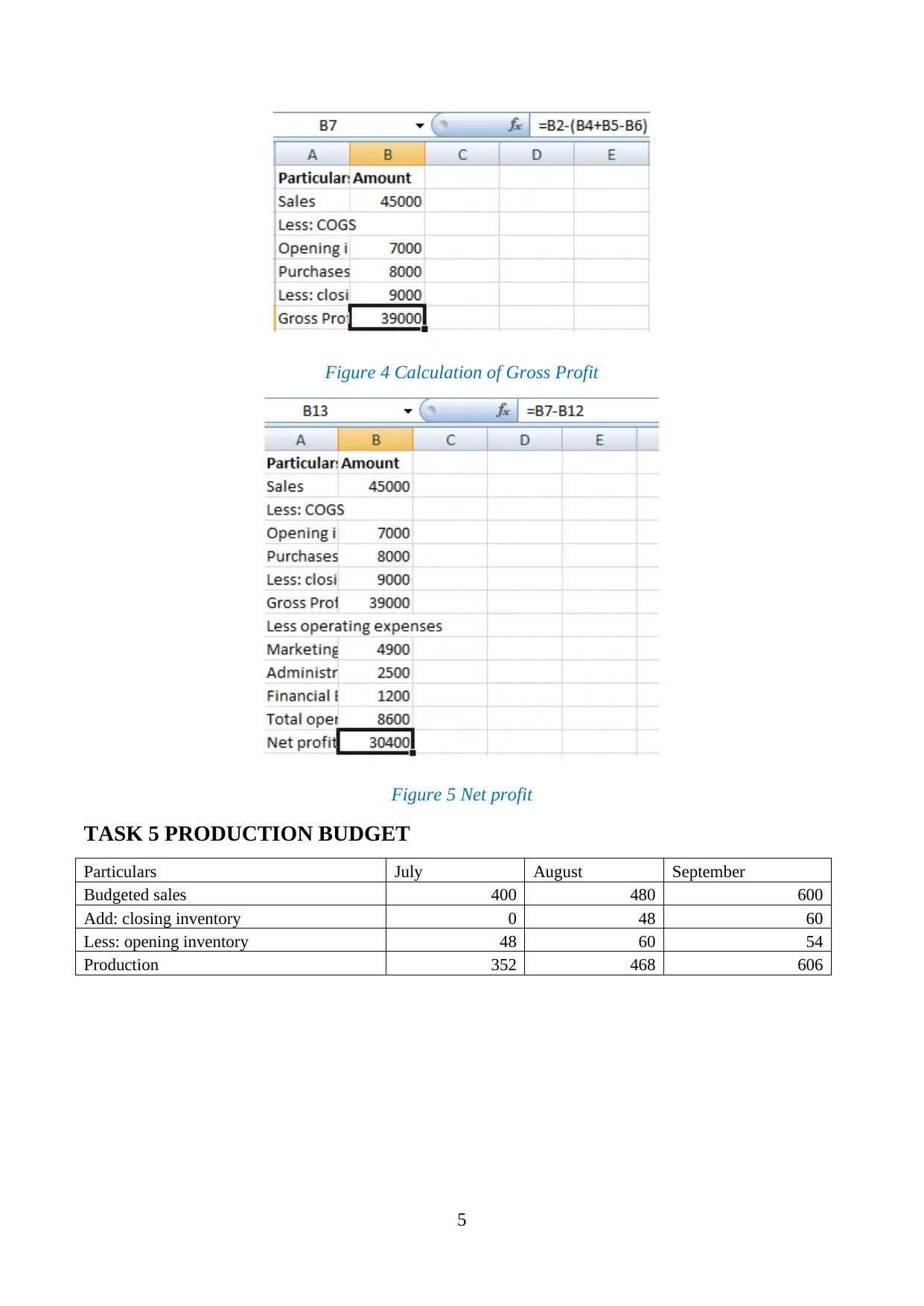
Figure 4 Calculation of Gross Profit
Figure 5 Net profit
TASK 5 PRODUCTION BUDGET
Particulars July August September
Budgeted sales 400 480 600
Add: closing inventory 0 48 60
Less: opening inventory 48 60 54
Production 352 468 606
5
Figure 5 Net profit
TASK 5 PRODUCTION BUDGET
Particulars July August September
Budgeted sales 400 480 600
Add: closing inventory 0 48 60
Less: opening inventory 48 60 54
Production 352 468 606
5
Paraphrase This Document
Need a fresh take? Get an instant paraphrase of this document with our AI Paraphraser

Working notes
Calculation of sales units
Particulars July August September October
Expected sales 6000 7200 9000 8100
Sales price 15 15 15 15
Sales unit 400 480 600 540
Calculation of Opening inventory
Particulars July August September October
Sales unit 400 480 600 540
Opening stock 48 60 54
TASK 6 PERFORMANCE REPORT
Prepare flexible budget
Particulars Variable cost per unit 180000 195000
Raw material 0.49 $ 88,338.46 $ 95,700.00
Direct labor 0.59 $ 105,923.08 $ 114,750.00
Variable factory overhead 2.92 $ 526,153.85 $ 570,000.00
Total variable costs $ 4.00 $ 720,415.38 $ 780,450.00
Fixed factory overhead $ 63,000.00 $ 62,500.00
Total fixed cost $ 63,000.00 $ 62,500.00
Total costs $ 783,415.38 $ 842,950.00
6
Calculation of sales units
Particulars July August September October
Expected sales 6000 7200 9000 8100
Sales price 15 15 15 15
Sales unit 400 480 600 540
Calculation of Opening inventory
Particulars July August September October
Sales unit 400 480 600 540
Opening stock 48 60 54
TASK 6 PERFORMANCE REPORT
Prepare flexible budget
Particulars Variable cost per unit 180000 195000
Raw material 0.49 $ 88,338.46 $ 95,700.00
Direct labor 0.59 $ 105,923.08 $ 114,750.00
Variable factory overhead 2.92 $ 526,153.85 $ 570,000.00
Total variable costs $ 4.00 $ 720,415.38 $ 780,450.00
Fixed factory overhead $ 63,000.00 $ 62,500.00
Total fixed cost $ 63,000.00 $ 62,500.00
Total costs $ 783,415.38 $ 842,950.00
6
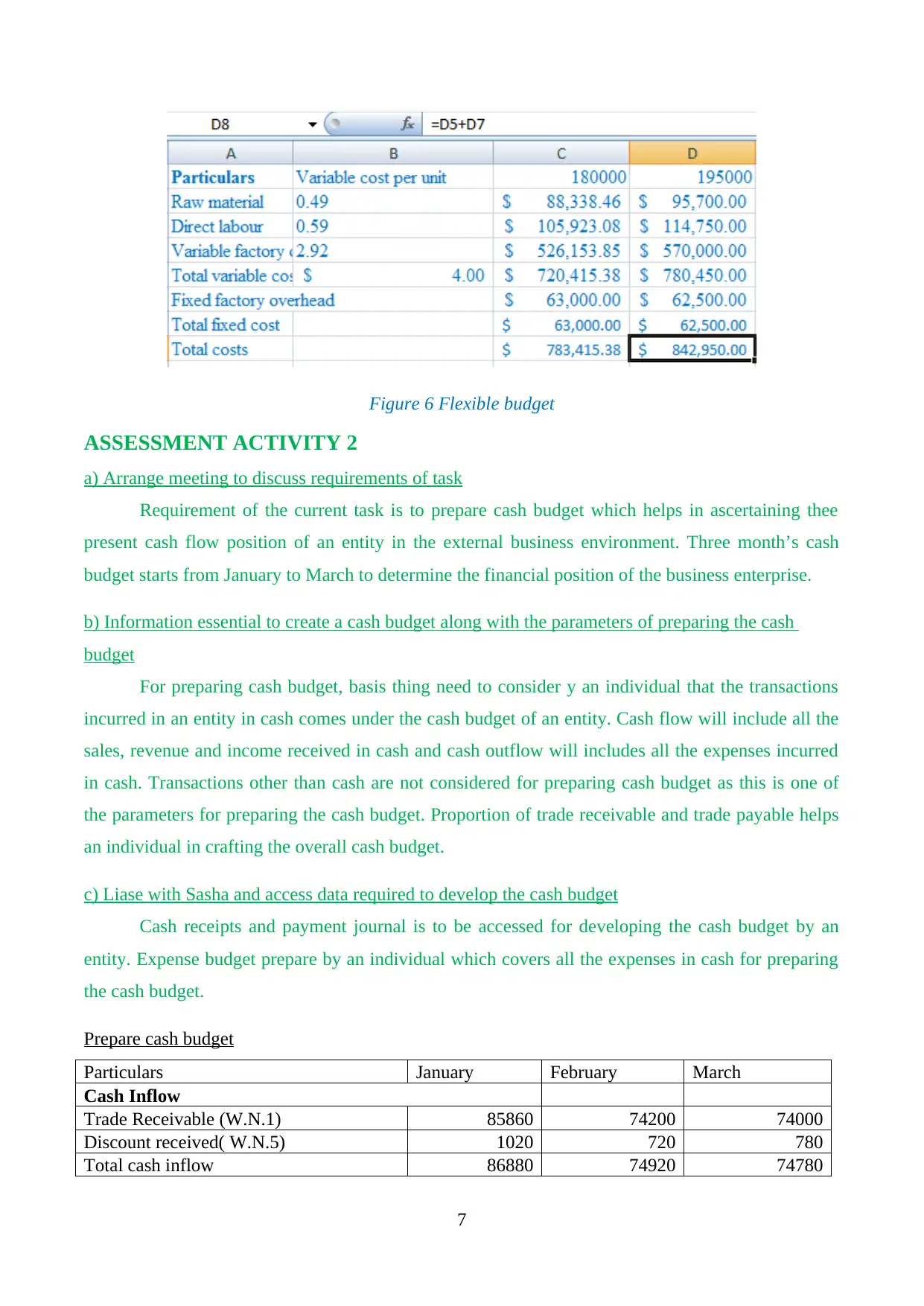
Figure 6 Flexible budget
ASSESSMENT ACTIVITY 2
a) Arrange meeting to discuss requirements of task
Requirement of the current task is to prepare cash budget which helps in ascertaining thee
present cash flow position of an entity in the external business environment. Three month’s cash
budget starts from January to March to determine the financial position of the business enterprise.
b) Information essential to create a cash budget along with the parameters of preparing the cash
budget
For preparing cash budget, basis thing need to consider y an individual that the transactions
incurred in an entity in cash comes under the cash budget of an entity. Cash flow will include all the
sales, revenue and income received in cash and cash outflow will includes all the expenses incurred
in cash. Transactions other than cash are not considered for preparing cash budget as this is one of
the parameters for preparing the cash budget. Proportion of trade receivable and trade payable helps
an individual in crafting the overall cash budget.
c) Liase with Sasha and access data required to develop the cash budget
Cash receipts and payment journal is to be accessed for developing the cash budget by an
entity. Expense budget prepare by an individual which covers all the expenses in cash for preparing
the cash budget.
Prepare cash budget
Particulars January February March
Cash Inflow
Trade Receivable (W.N.1) 85860 74200 74000
Discount received( W.N.5) 1020 720 780
Total cash inflow 86880 74920 74780
7
ASSESSMENT ACTIVITY 2
a) Arrange meeting to discuss requirements of task
Requirement of the current task is to prepare cash budget which helps in ascertaining thee
present cash flow position of an entity in the external business environment. Three month’s cash
budget starts from January to March to determine the financial position of the business enterprise.
b) Information essential to create a cash budget along with the parameters of preparing the cash
budget
For preparing cash budget, basis thing need to consider y an individual that the transactions
incurred in an entity in cash comes under the cash budget of an entity. Cash flow will include all the
sales, revenue and income received in cash and cash outflow will includes all the expenses incurred
in cash. Transactions other than cash are not considered for preparing cash budget as this is one of
the parameters for preparing the cash budget. Proportion of trade receivable and trade payable helps
an individual in crafting the overall cash budget.
c) Liase with Sasha and access data required to develop the cash budget
Cash receipts and payment journal is to be accessed for developing the cash budget by an
entity. Expense budget prepare by an individual which covers all the expenses in cash for preparing
the cash budget.
Prepare cash budget
Particulars January February March
Cash Inflow
Trade Receivable (W.N.1) 85860 74200 74000
Discount received( W.N.5) 1020 720 780
Total cash inflow 86880 74920 74780
7
⊘ This is a preview!⊘
Do you want full access?
Subscribe today to unlock all pages.

Trusted by 1+ million students worldwide
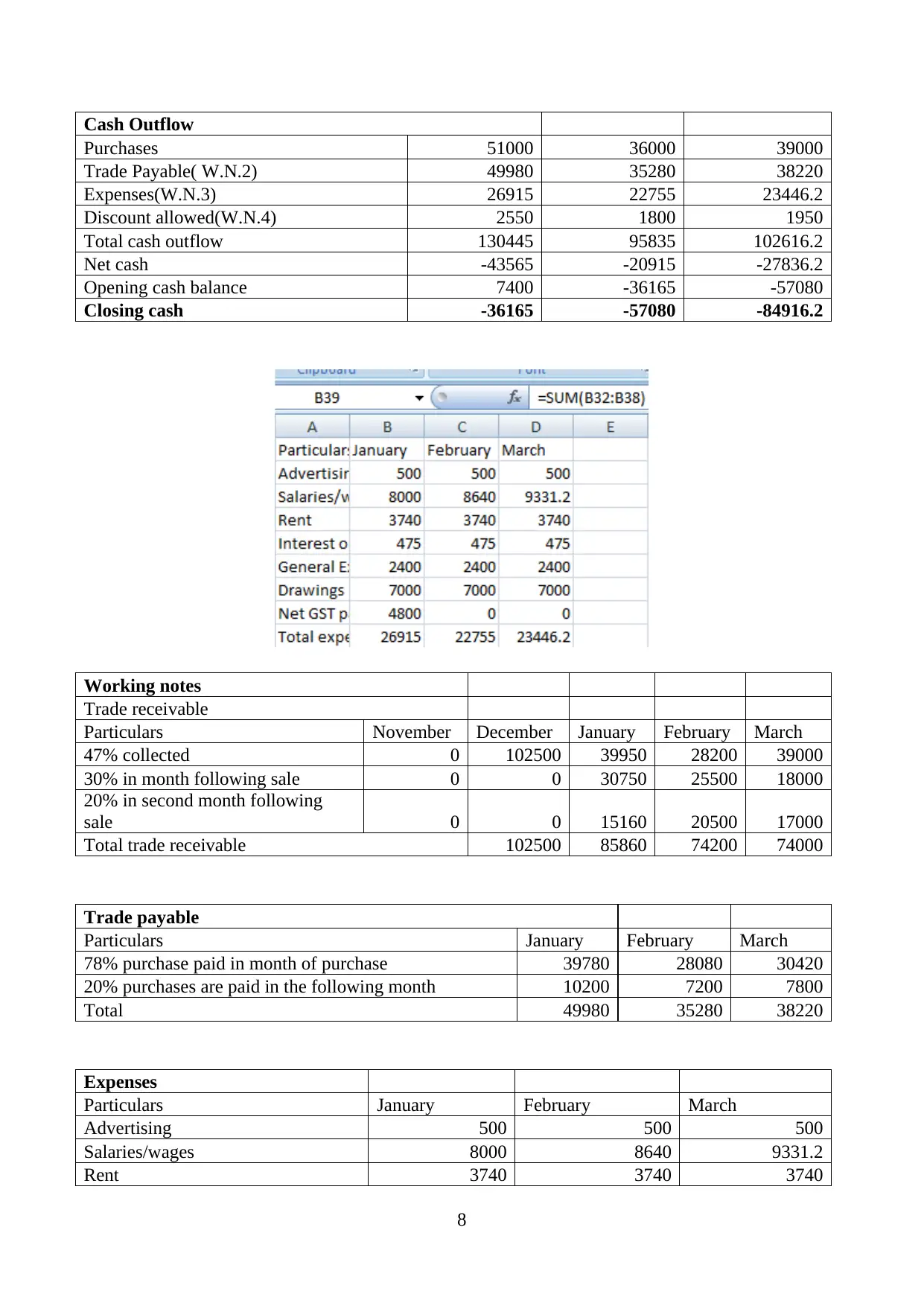
Cash Outflow
Purchases 51000 36000 39000
Trade Payable( W.N.2) 49980 35280 38220
Expenses(W.N.3) 26915 22755 23446.2
Discount allowed(W.N.4) 2550 1800 1950
Total cash outflow 130445 95835 102616.2
Net cash -43565 -20915 -27836.2
Opening cash balance 7400 -36165 -57080
Closing cash -36165 -57080 -84916.2
Working notes
Trade receivable
Particulars November December January February March
47% collected 0 102500 39950 28200 39000
30% in month following sale 0 0 30750 25500 18000
20% in second month following
sale 0 0 15160 20500 17000
Total trade receivable 102500 85860 74200 74000
Trade payable
Particulars January February March
78% purchase paid in month of purchase 39780 28080 30420
20% purchases are paid in the following month 10200 7200 7800
Total 49980 35280 38220
Expenses
Particulars January February March
Advertising 500 500 500
Salaries/wages 8000 8640 9331.2
Rent 3740 3740 3740
8
Purchases 51000 36000 39000
Trade Payable( W.N.2) 49980 35280 38220
Expenses(W.N.3) 26915 22755 23446.2
Discount allowed(W.N.4) 2550 1800 1950
Total cash outflow 130445 95835 102616.2
Net cash -43565 -20915 -27836.2
Opening cash balance 7400 -36165 -57080
Closing cash -36165 -57080 -84916.2
Working notes
Trade receivable
Particulars November December January February March
47% collected 0 102500 39950 28200 39000
30% in month following sale 0 0 30750 25500 18000
20% in second month following
sale 0 0 15160 20500 17000
Total trade receivable 102500 85860 74200 74000
Trade payable
Particulars January February March
78% purchase paid in month of purchase 39780 28080 30420
20% purchases are paid in the following month 10200 7200 7800
Total 49980 35280 38220
Expenses
Particulars January February March
Advertising 500 500 500
Salaries/wages 8000 8640 9331.2
Rent 3740 3740 3740
8
Paraphrase This Document
Need a fresh take? Get an instant paraphrase of this document with our AI Paraphraser

Interest on mortgage 475 475 475
General Expenses 2400 2400 2400
Drawings 7000 7000 7000
Net GST payable 4800 0 0
Total expenses 26915 22755 23446.2
Discount allowed
Particulars January February March
Sales 85000 60000 65000
Discount allowed 2550 1800 1950
Discount received
Particulars January February March
Purchases 51000 36000 39000
Discount received 1020 720 780
ASSESSMENT ACTIVITY 3
a) Discuss the parameters of budgeted income statement, cash budget and balance sheet
Assumptions form an important part for preparing the financial budgets which helps in
determining the overall position of an entity in the external environment. Balancing ledgers are
prepared to determine the balancing figure which will be considered in the financial budgets.
b) Access data to develop the documents required in preparing budgets
The preparation of the financial budgets require cash book, bank statements, assets
scheduled, liability schedule, debtors account and creditors account.
c) Prepare financial budgets
Budgeted income statement of the year
Particulars Amount
Sales 420000
Less: Cost of sales
Opening stock 2400
Purchases 2000
Closing stock 2000
Total COGS 2400
GP 417600
Operating expenses
Depreciation 8000
Interest on mortgage 1200
Advertising 17200
9
General Expenses 2400 2400 2400
Drawings 7000 7000 7000
Net GST payable 4800 0 0
Total expenses 26915 22755 23446.2
Discount allowed
Particulars January February March
Sales 85000 60000 65000
Discount allowed 2550 1800 1950
Discount received
Particulars January February March
Purchases 51000 36000 39000
Discount received 1020 720 780
ASSESSMENT ACTIVITY 3
a) Discuss the parameters of budgeted income statement, cash budget and balance sheet
Assumptions form an important part for preparing the financial budgets which helps in
determining the overall position of an entity in the external environment. Balancing ledgers are
prepared to determine the balancing figure which will be considered in the financial budgets.
b) Access data to develop the documents required in preparing budgets
The preparation of the financial budgets require cash book, bank statements, assets
scheduled, liability schedule, debtors account and creditors account.
c) Prepare financial budgets
Budgeted income statement of the year
Particulars Amount
Sales 420000
Less: Cost of sales
Opening stock 2400
Purchases 2000
Closing stock 2000
Total COGS 2400
GP 417600
Operating expenses
Depreciation 8000
Interest on mortgage 1200
Advertising 17200
9
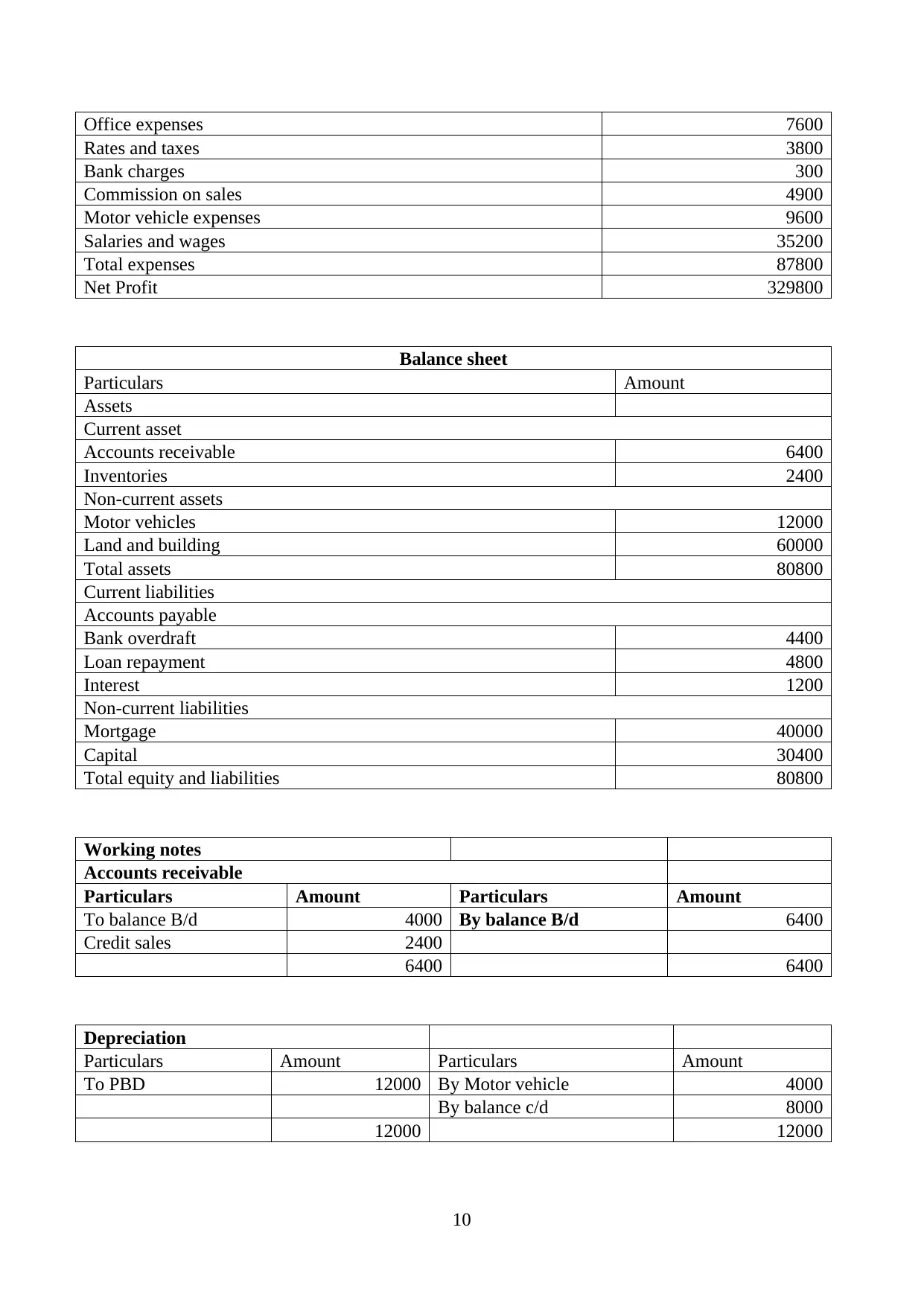
Office expenses 7600
Rates and taxes 3800
Bank charges 300
Commission on sales 4900
Motor vehicle expenses 9600
Salaries and wages 35200
Total expenses 87800
Net Profit 329800
Balance sheet
Particulars Amount
Assets
Current asset
Accounts receivable 6400
Inventories 2400
Non-current assets
Motor vehicles 12000
Land and building 60000
Total assets 80800
Current liabilities
Accounts payable
Bank overdraft 4400
Loan repayment 4800
Interest 1200
Non-current liabilities
Mortgage 40000
Capital 30400
Total equity and liabilities 80800
Working notes
Accounts receivable
Particulars Amount Particulars Amount
To balance B/d 4000 By balance B/d 6400
Credit sales 2400
6400 6400
Depreciation
Particulars Amount Particulars Amount
To PBD 12000 By Motor vehicle 4000
By balance c/d 8000
12000 12000
10
Rates and taxes 3800
Bank charges 300
Commission on sales 4900
Motor vehicle expenses 9600
Salaries and wages 35200
Total expenses 87800
Net Profit 329800
Balance sheet
Particulars Amount
Assets
Current asset
Accounts receivable 6400
Inventories 2400
Non-current assets
Motor vehicles 12000
Land and building 60000
Total assets 80800
Current liabilities
Accounts payable
Bank overdraft 4400
Loan repayment 4800
Interest 1200
Non-current liabilities
Mortgage 40000
Capital 30400
Total equity and liabilities 80800
Working notes
Accounts receivable
Particulars Amount Particulars Amount
To balance B/d 4000 By balance B/d 6400
Credit sales 2400
6400 6400
Depreciation
Particulars Amount Particulars Amount
To PBD 12000 By Motor vehicle 4000
By balance c/d 8000
12000 12000
10
⊘ This is a preview!⊘
Do you want full access?
Subscribe today to unlock all pages.

Trusted by 1+ million students worldwide
1 out of 21
Related Documents
Your All-in-One AI-Powered Toolkit for Academic Success.
+13062052269
info@desklib.com
Available 24*7 on WhatsApp / Email
![[object Object]](/_next/static/media/star-bottom.7253800d.svg)
Unlock your academic potential
Copyright © 2020–2026 A2Z Services. All Rights Reserved. Developed and managed by ZUCOL.




